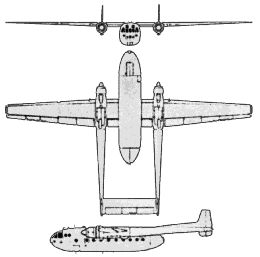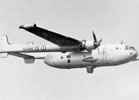
COMBINED MOTORIZATION TRAINING/ TEST AIRCRAFT
HISTORY
Program's genesis
By the end of World War II,
the French Air Force flew a motley fleet of transport aircraft which was
not fitted to carry heavy loads. Various projects were launched, including
the NC.211 Cormoran, a four-engined plane able to carry up to 13 tons
on a range of 1,000 km. Unfortunately, it was cancelled in 1950. It was decided
to power the second prototype with English Bristol Hercules type
739 engines, developing 2,040 hp on takeoff, to which Rotol four
blade props were fitted. From then on it was designated Nord 2501.
This prototype crashed on July 6th 1952 at Lyon-Bron, killing all
five people aboard, including famous female aviator Maryse Bastié.
In the same period, in 1947, the Direction
Technique Industrielle (Industrial Technical Office) released specifications
based on studies for a middle weight aircraft which's new conception allowed
for an easy use. The Société Nationale de Construction
Aéronautique du Nord (National Corporation of Northern Aeronautical
Construction) with the Nord 2500 and Breguet with the Br.891R Mars fulfilled
those requirements. At the same time, the SNCASO (Société
Nationale de Construction Aéronautique du Sud-Ouest/ National
Corporation of South Western Aeronautical Construction) offered the SO.30C.
.
Jean Calvy, a SNCAN's engineer, came
up with a combination for a high-wing airframe with two booms around a
central fuselage with a clamshell opening at it's rear. It would be powered
by two Gnôme-et-Rhône 14R, 1.600 hp engines, fitted with 3
blade variable pitch propellers.
On April 27th 1948, the DTI asked
the SNCAN to build 2 prototypes. The first one was built at the Issy-les-Moulineaux
factory, then taken apart and shipped to Melun-Villaroche where it was
assembled and checked. It made it's first flight on September 10th 1949
in the hands of Claude Chautemps and Georges Détré.
The selection eventually designated the Nord 2501. The first order
was placed on July 10th 1951, and the first production aircraft
flew on November 24th 1952, in the hands of Georges Détré.
Not until early 1953 was the plane dubbed Noratlas.
426 aircraft of all versions
were eventually produced, including 8 prototypes and 3 pre-production
aircraft.
While the SNCAN factory at Les
Mureaux manufactured the booms and tails, the factory at Bourges
made the fuselage. Breguet manufactured the wings and, under licensing,
the Rotol propellers. SNECMA also had a licence for the Hercules
738 and 739 engines. Initially the final assembly took place at
either Les Mureaux or Bourges, at the end only Bourges did it.

The Noratlas was engaged in Indochina, Suez, Algeria and even in Chad in 1984. It also participated in many humanitarian and scientific missions throughout the world.
Portuguese Noratlas' were also engaged in Angola, in Mozambique and Guinea-Bissau.
During the 1968 strikes in France, the Noratlas' flew, from May 20th to June 8th, 1,307 missions for mail and passenger transport, or 2,025 total hours. More than 22,000 passengers were transported.
The Armée de l'Air even created a Noratlas Demonstration Team, called " La Guimauve " (The Marshmallow), equipped with up to 7 planes.
The Noratlas was eventually taken out of service officially on September 2nd 1986 at Toulouse, but in practice the plane continued to fly on until October 26th 1989 and the retirement of the " Gabriel " ELINT version.
The Noratlas was nicknamed " La Grise " by the French Air Force.
A sole example in service within the Aéronautique Navale during 27 years
Concept Compared to the Nord
2501 Noratlas, the 2504 (just like the 2502) had 2 Turboméca
Marboré II 400 kg turbojets. Fitted on the wingtips, they
used piston engine fuel, and like the J-34 that equipped the P2V-7,
had built in intake covers (to protect them from salt water) that
opened only when the engine was working. The wing was also strengthened
and fitted with 6 hardpoints, each capable of 200 kg loads.
The story of the N.2504 in the French
Navy started with a need, in the 1950s, for a new heavy, multi-engine
ASW and patrol aircraft. This was also the period which saw the success
of the Nord 2501 Noratlas, which first flew on September 10th 1949, and
of which 400+ were built. The Noratlas was thus a natural contender, and
the Navy tested it and found it solid and resistant, and especially appreciated
its important payload.
Faced with the Navy's requirements,
Nord first offered a simple ASW version of the N.2502, but it was quickly
abandoned, due to the strong competition : Breguet 754, Hurl Dubois 35
and Bloch 161. Eventually the Navy favoured the P2V-6 Neptune. The N.2502
was one of many derivatives from the 2501, and was originally built for
civilian companies operating from Africa, which needed aircraft capable
of short takeoffs in hot weather. It was therefor fitted with either Marboré
II or RAMA II 400 kg turbojets on both wingtips.
The Navy was nevertheless very impressed
by this airframe, and asked Nord to study a training version based on
the ASW N.2502. This new version was called N.2504, and was finally ordered
: order n° 3229/57 was for a full scale mock-up and a prototype ;
value of the contract was 530 million Frs. The contract also specified
that the pane was to fly before December 31st 1958.
The full scale wooden mock-up was
built at Châtillon-sous-Bagneux, and shortly after that the prototype
was assembled at the S.N.C.A.N. factory. The airframe is identical ti
that of the 2502, and the interior is up to date with Navy requirements.
Prototype N.2504 n°01 finally
flew on November 17 1958 from the Melun-Villaroche airfield with Jean
Caillaud in the cockpit. After a brief stay at the C.E.V. (Flight Test
Center), the prototype was taken over by the C.E.P.A. (Navy Test and Evaluation
Center) on June 24th 1959, flown by Arland Jacquet ; by then the plane
had already flown 85 hours. The 1957 budget had announced for 5 aircraft,
but financial difficulties saw this order cancelled ; the prototype will
be the only N.2504 ever delivered to the Navy, which will assign it to
flight 10.S.
In unit On December 2nd 1959,
the Nord 2504 was one of the only survivors of the Malpasset tragedy
: a damn broke and flooded the valley - and the base. Most aircraft
were lost but the Noratlas survived by miracle. Within flight 10.S,
the plane had two main missions : ASW and maritime patrol (PATMAR)
training, and especially avionics and equipment testing.
Since the airplane also was also supposed
to serve as a flying testbed, it was assigned to flight
10.S at N.A.S.
Fréjus Saint-Raphaël,
the Navy's unit in charge with tests and experiments.
Training missions
For these missions the airframe was
entirely transformed into a schoolroom. Not only did it receive an entire
ASW suit (double sonobuoy launcher, dinghy, retractable radar antenna),
but the cargo bay was fitted with enough tables and seats for one instructor
and 16 students. Such missions could last up to several hours, and replicate
the exact conditions of ASW or PATMAR missions.
The testing and evaluation mission This equipment was powered
by a Gevaudan auxiliary power unit located on the right side of
the fuselage, just below the wing.
As a testbed, the Nord 2504 was fitted
with many different avionics systems, antennae and probes.
The airplane was officially
retired from active service by the Navy on august 1st 1987, having
by then flown 6,850 hours. Its last flight took place on June 26th
1988 when it was flown to the Aix-le-Milles airfield and handed
over to the " Pégase " association. For this last flight
pilots were VAE Doniol (head of Naval Aviation Central Services)
and CF Astraud.

MISCELLANEOUS
MOTORIZATION -Two Bristol Hercules 791 of 2.000
hp each.

-Two Turboméca Marboré
II jet engines of 400 kg each.
![]()
sources - acknowledgements
:
Amiral Guirec Doniol, chef du Service Central de l'Aéronautique
Navale en 1986-1989.
Louis Rogelet
Hervé Brun
Pierre Pecastaingts
www.cocardes.com
www.aviation-fr.info
[AIRCRAFT MENU] [MAIN MENU] [HOME]
©French Fleet Air Arm. www.ffaa.net. All rights reserved.

